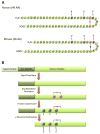New insights into the biology of osteocalcin
- PMID: 26055108
- PMCID: PMC4670816
- DOI: 10.1016/j.bone.2015.05.046
New insights into the biology of osteocalcin
Abstract
Osteocalcin is among the most abundant proteins in bone and is produced exclusively by osteoblasts. Initially believed to be an inhibitor of bone mineralization, recent studies suggest a broader role for osteocalcin that extends to the regulation of whole body metabolism, reproduction, and cognition. Circulating undercarboxylated osteocalcin, which is regulated by insulin, acts in a feed-forward loop to increase β-cell proliferation as well as insulin production and secretion, while skeletal muscle and adipose tissue respond to osteocalcin by increasing their sensitivity to insulin. Osteocalcin also acts in the brain to increase neurotransmitter production and in the testes to stimulate testosterone production. At least one putative receptor for osteocalcin, Gprc6a, is expressed by adipose, skeletal muscle, and the Leydig cells of the testes and appears to mediate osteocalcin's effects in these tissues. In this review, we summarize these new discoveries, which suggest that the ability of osteocalcin to function both locally in bone and as a hormone depends on a novel post-translational mechanism that alters osteocalcin's affinity for the bone matrix and bioavailability. This article is part of a Special Issue entitled Bone and diabetes.
Keywords: Diabetes; Metabolism; Osteoblast; Osteocalcin.
Copyright © 2015 Elsevier Inc. All rights reserved.
Conflict of interest statement
Conflicts of interest: none
Figures


References
-
- Clemens TL, Karsenty G. The osteoblast: an insulin target cell controlling glucose homeostasis. J Bone Miner Res. 2011;26:677–680. - PubMed
-
- Bolton JG, Patel S, Lacey JH, White S. A prospective study of changes in bone turnover and bone density associated with regaining weight in women with anorexia nervosa. Osteoporos Int. 2005;16:1955–1962. - PubMed
-
- Nussbaum M, Baird D, Sonnenblick M, Cowan K, Shenker IR. Short stature in anorexia nervosa patients. J Adolesc Health Care. 1985;6:453–455. - PubMed
Publication types
MeSH terms
Substances
Grants and funding
LinkOut - more resources
Full Text Sources
Other Literature Sources
Medical

